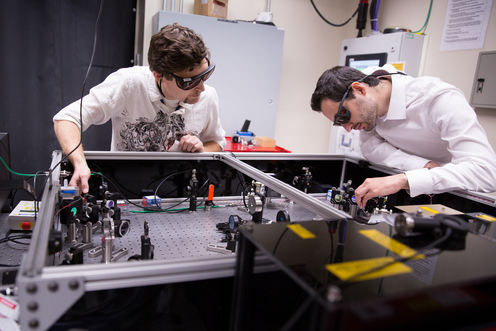
SLAC National Accelerator Laboratory at Stanford
By Ian Bailey, Lancaster University
Scientists working on an experiment at the SLAC National Accelerator Laboratory in the US have taken a step forward in developing a technology which could significantly reduce the size of particle accelerators. The technology is able to accelerate particles more rapidly than conventional accelerators at a much smaller size.
One of the most impressive aspects of particle accelerators used for research such as the Large Hadron Collider (LHC) at CERN is its physical size. Yet, even with a circumference of 27km, the LHC would be smaller than most of the next generation of proposed colliders. For example the International Linear Collider (ILC), a possible future collider of electrons and positrons (anti-electrons) could be 31km long, and there is even a proposal for a circular accelerator with an 80km circumference that could be built at CERN as part of the Future Circular Colliders (FCC) project.
The size of all of these machines is determined by our ability to build structures that can transfer energy to particles allowing us to accelerate them to greater speeds. The higher the speed, the greater the energy when these particle beams collide, giving scientists a better chance of answering fundamental questions about the universe. This is because higher energy collisions can create conditions that are similar to those existing when the universe was born.
Most current accelerators use a structure called an “rf cavity”, a carefully designed “box” through which the particle beam passes. The cavity transfers electromagnetic energy into the kinetic energy of particles, accelerating them. However, there is a limit to the amount of energy that an rf cavity can transfer to particles. This is because, despite operating in a vacuum, there is a risk that increasing electromagnetic fields can lead to lightning-like discharges of energy.
However, even routine experiments in places like the LHC require more energy than a single rf cavity can provide. That is why the current solution is to use very many cavities arranged in a straight line, if it is a linear machine such as the SLAC, or using the same cavity very many times if it is in a circular machine, such as the LHC.
Either solution presents challenges and requires a large machine to fit in the many parts needed. This raises the costs. Any technology which can increase the acceleration with smaller parts and without the need for more machinery will make future accelerators more compact.
This matters because particle accelerators are not just for particle physicists. They are increasingly used in medicine, industry and security. For example, accelerators provide X-rays and particle beams for cancer therapy, for the fabrication of minuscule devices and for scanning the contents of everything from suitcases to freight containers.
The new technology which could promise more compact particle accelerators has just been published in a study in Nature. The study suggests that, if bunches of electrons are passed through a short column of lithium vapour “plasma” in rapid succession, the electric field of the plasma is able to translate enough energy to accelerate particles hundreds of times quicker than the LHC. It is able to achieve all this while only being 30cm in length.
Plasma is a state of matter where atoms are broken down into positively charged ions and negatively charged electrons. Most of the matter in the sun exists as plasma, but we can create that state on Earth using high energy lasers.
The electric field between particles in a plasma can be extremely high. In this experiment, as the bunch of electrons passes through the plasma it causes the electrons of the plasma to move, leaving behind it a region of oscillating electrons. It is this oscillation which generate the “wakefield” which can then be used to accelerate a second set of trailing electrons following very close behind the first bunch.
Although previous experiments have shown even greater gains in energy, what makes this experiment interesting is the number of electrons accelerated and how evenly each of them acquires energy. Being able to accelerate large numbers of particles to the same energy simultaneously is a prerequisite for any future practical use of this technology called “plasma wakefield acceleration”.
Other groups around the world including the AWAKE collaboration at CERN and the ALPHA-X collaboration based at the University of Strathclyde are pursuing different approaches to plasma wakefield acceleration using proton beams or lasers to generate the wakefield. Meanwhile there are already tentative designs being proposed for future accelerators that could make use of this technology, if accelerating large numbers of particles simultaneously can be made reliable.![]()
Ian Bailey, Lecturer at Lancaster University, receives funding from the STFC (Science and Technology Facilities Council).
This article was originally published on The Conversation. Read the original article.



Comments